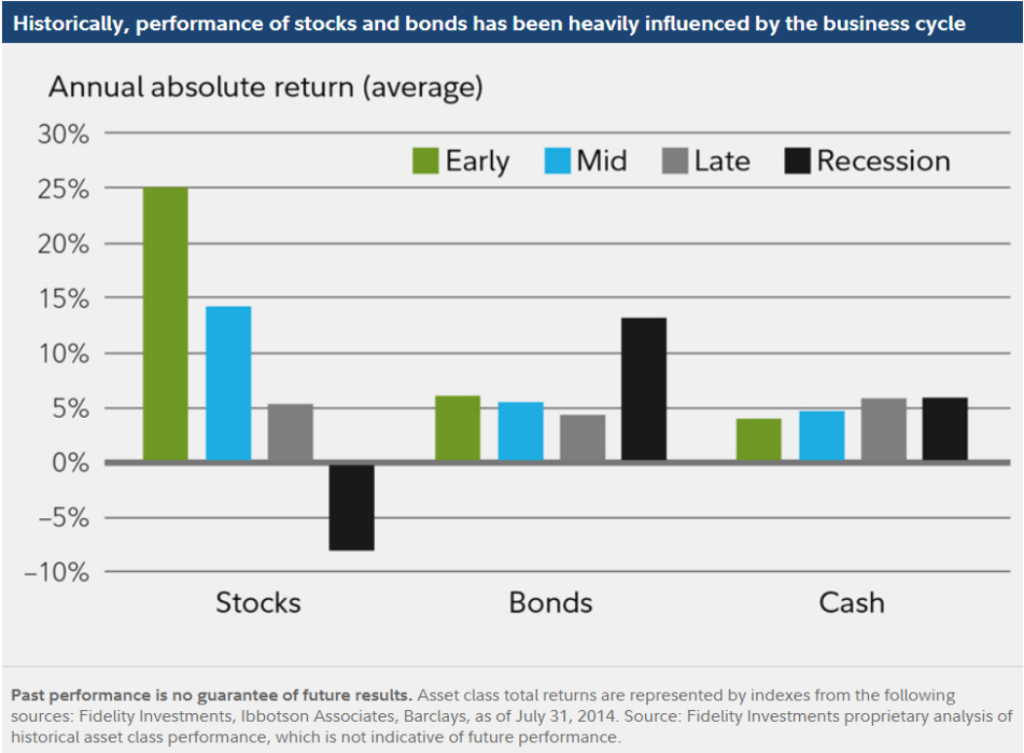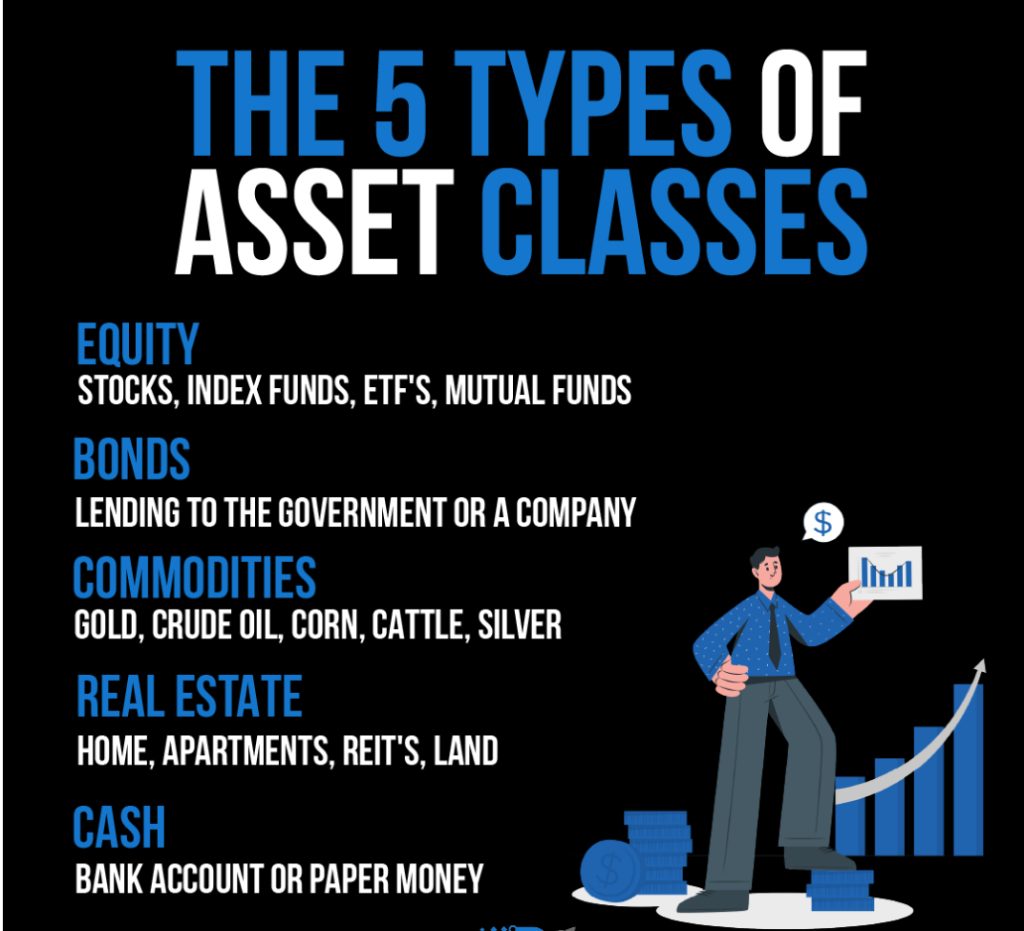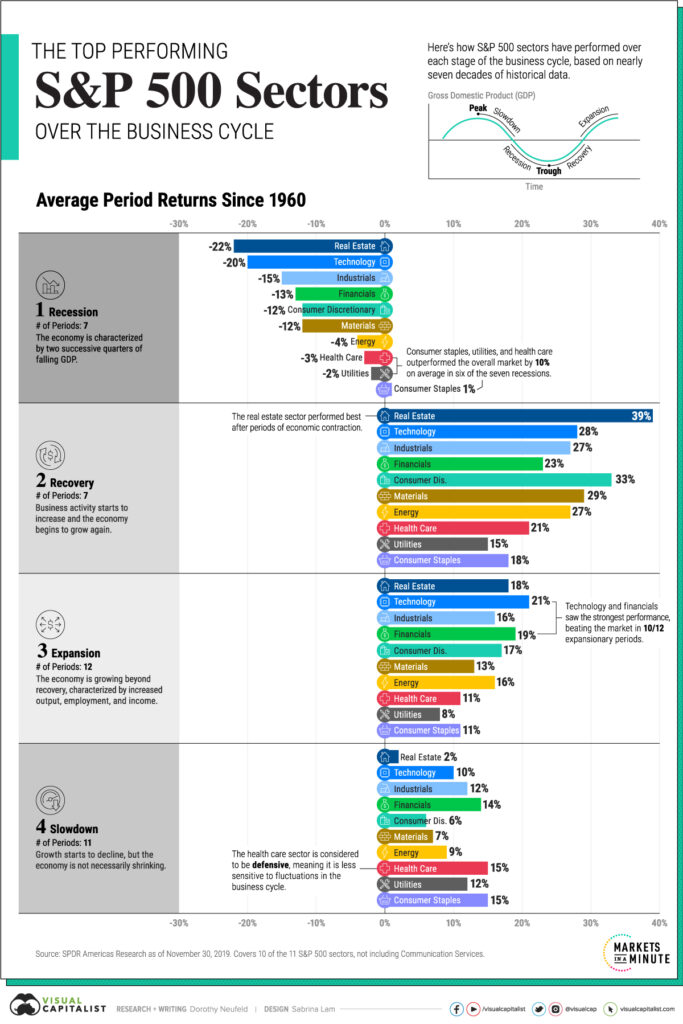Wydajność aktywów na różnych etapach cyklu koniunkturalnego
Główne cele edukacyjne:
Wstęp: This chapter focuses on how different asset classes, including stocks, bonds, cash, real estate, I commodities, perform during various stages of the business cycle. Understanding this interplay is crucial for informed investment decisions.
- Understand Jak stocks, bonds, I cash typically perform during expansion, peak, contraction, and trough phases of the business cycle.
- Uczyć się about the role of real estate I commodities in investment portfolios and how these asset classes are affected across different business cycle stages.
- Discover the impact of macroeconomic factors like interest rates, consumer confidence, and inflation on different asset classes.
- Badać the concept of dywersyfikacja across asset classes to mitigate risks associated with business cycle fluctuations.
Introduction to Business Cycles and Asset Classes
Every investor must understand the concept of business cycles and how different asset classes perform during its various stages. The business cycle, which comprises expansion, peak, contraction, and trough, impacts the economy, which in turn influences asset class performance. The three primary asset classes we’ll examine are stocks, bonds, and cash. Let’s dive in to see how these assets respond to the different phases of the business cycle.
Stocks, Bonds, and Cash: A Primer
Before delving into the specifics, let’s understand what these asset classes entail. Stocks represent shares of ownership in a company. Bonds are debt securities, essentially loans made by an investor to a corporate or government entity. Cash equivalents are the safest form of investment, including money market funds and Treasury bills.

Tytuł rysunku: Impact of Business Cycle on Stocks and Bonds Performance
Źródło: Wierność
Opis: The figure illustrates the historical performance of stocks, bonds, and cash throughout different phases of the business cycle. It showcases the annual absolute return (average) for each asset class during early, mid, late, and recession phases of the cycle. The graph emphasizes that the performance of these assets is significantly influenced by the business cycle.
Najważniejsze wnioski:
- Stocks tend to have higher volatility in returns across different business cycle phases.
- Bonds and cash show more stability, especially during recessionary periods.
- The highest returns for stocks are observed during the early phase of the business cycle.
- The data is based on historical performance up to July 31, 2014, and past performance is not indicative of future results.
Aplikacja: Investors can use this data to strategize their portfolio allocation based on the current phase of the business cycle. Understanding the historical performance of asset classes during different business cycle phases can guide investment decisions, helping investors mitigate risks and capitalize on potential returns.
🌱Early Expansion Phase
During the early expansion phase, the economy begins to recover from a recession. Here, stocks typically perform well as company profits start growing, consumer confidence improves, and spending increases. Bonds usually underperform during this phase as interest rates rise, reducing bond prices. Cash equivalents, while safe, do not offer high returns, making them less attractive.
📈Mid Expansion Phase
As the expansion matures, the economy reaches a steady state of growth. Stocks generally continue to perform well, although the pace may slow as the growth becomes more predictable. Bonds can offer moderate returns as interest rate increases level off. Cash continues to deliver modest but stable returns.
📊Late Expansion Phase
In the late expansion phase, inflation may begin to rise as the economy overheats. Stocks might start to perform less well as interest rates increase to curb inflation, making borrowing more expensive for companies. Bonds usually underperform due to higher inflation and rising interest rates. However, cash equivalents become more attractive due to increased yields.
📉Recession
During a recession, economic activity slows, and company profits often decrease. Stocks typically underperform due to poor earnings and negative sentiment. Bonds, particularly government and high-quality corporate bonds, usually perform well as investors seek safer assets, and central banks lower interest rates. Cash equivalents are also seen as safe havens during this period, offering stability though with modest returns.
Understanding how different asset classes perform throughout the business cycle can enhance your investment strategy. Generally, stocks tend to outperform in expansion phases while bonds and cash equivalents can be safer choices during recessions. However, every cycle can vary, and other factors such as fiscal policy, geopolitics, and investor sentiment also influence asset performance. Therefore, continuous monitoring and flexible portfolio adjustments are crucial for successful investing.

Postać: The infographic provides a clear breakdown of the five primary types of asset classes. It categorizes them into Equity, Bonds, Commodities, Real Estate, and Cash. Each category is further elaborated with examples. For instance, under Equity, it lists stocks, index funds, ETFs, and mutual funds. This visual guide is essential for beginners in finance and investment to understand the diverse avenues available for investment.
Rada: When considering investments, it’s crucial to diversify across different asset classes to mitigate risks. Each asset class has its own set of advantages and potential risks, so understanding them can help in making informed investment decisions.
Źródło: Infografika niestandardowa
Real Estate and Commodities: An Overview
Real estate involves investing in properties for rental income, capital appreciation, or both. Commodities include raw materials or primary agricultural products, like gold, oil, wheat, or cotton. These asset classes can provide diversification and hedge against inflation.
Real Estate Across Business Cycle Stages
🏠Early Expansion: Real estate typically performs well as economic activity starts to pick up. Lower interest rates make borrowing for mortgages more attractive, pushing property prices up.
🏘️Mid Expansion: During this phase, real estate can continue to offer stable returns. Demand for property generally remains strong due to steady economic growth.
🏢Late Expansion: In this phase, real estate performance can vary. Rising interest rates make mortgages less affordable, potentially slowing down property demand and price growth. However, rental income may increase due to higher inflation.
🏚️Recession: Real estate often underperforms during a recession. High-interest rates, unemployment, and reduced consumer confidence can decrease property demand and prices.
Commodities Across Business Cycle Stages
🌾Early Expansion: Commodities can perform well in the early expansion phase. Increasing industrial production often boosts demand for commodities, leading to higher prices.
⛏️Mid Expansion: Commodities may continue to provide decent returns as economic activity remains robust. However, the performance can be uneven due to supply/demand dynamics specific to each commodity.
🛢️Late Expansion: In the late expansion phase, commodities, especially precious metals like gold, can serve as an inflation hedge and perform well.
⚒️Recession: During a recession, commodities generally underperform due to reduced industrial activity and lower demand. However, precious metals may perform well as investors seek safe-haven assets.

Tytuł rysunku: Performance of S&P 500 Sectors Over the Business Cycle
Źródło: Kapitalista wizualny
Opis:Rysunek podkreśla znaczenie dywersyfikacji portfela, ilustrując, jak różne sektory indeksu S&P 500 zachowują się na różnych etapach cyklu koniunkturalnego.
Najważniejsze wnioski:
- Faza recesji:
- Najlepiej prosperujące sektory:Nieruchomości, technologia, przemysł, finanse, dobra konsumpcyjne uznaniowe i materiały.
- Odzyskiwanie rynku:
- Najlepiej prosperujące sektory:Nieruchomości, technologia, przemysł, finanse, dobra konsumpcyjne uznaniowe, materiały, energia, opieka zdrowotna i media.
- Faza ekspansji:
- Najlepiej prosperujące sektory: Technologia, nieruchomości, przemysł, finanse, dobra konsumpcyjne uznaniowe, energia, opieka zdrowotna i inne. Sektory te odnotowują wzrost, choć w wolniejszym tempie w porównaniu z fazą ożywienia.
- Faza recesji:
- Skurcz/zwolnienie:
- Najlepiej prosperujące sektory:Sektory dóbr konsumpcyjnych pierwszej potrzeby, usług komunalnych, opieki zdrowotnej i energii osiągają lepsze wyniki.
Aplikacja:Zrozumienie cyklicznej wydajności sektorów może być kluczowe dla inwestorów, którzy chcą maksymalizować zwroty i minimalizować ryzyko w czasie. Poprzez strategiczną dywersyfikację swoich portfeli w oparciu o spostrzeżenia dotyczące wydajności sektorowej w różnych fazach cyklu koniunkturalnego inwestorzy mogą potencjalnie czerpać korzyści zarówno z aprecjacji kapitału, jak i ochrony przed spadkami.
Wniosek:
Just like stocks, bonds, and cash equivalents, real estate and commodities respond differently to various stages of the business cycle. Real estate is typically influenced by interest rates and economic growth, while commodities are often impacted by supply and demand dynamics and can act as an inflation hedge. Understanding these nuances can help diversify your investment portfolio and manage risk effectively.
Najważniejsze wnioski:
Oświadczenie końcowe: Recognizing how various asset classes perform throughout the business cycle stages can significantly enhance your investment strategy. While stocks may offer higher returns during expansion phases, bonds and cash equivalents often provide stability during recessions. Real estate and commodities add diversification benefits and can serve as inflation hedges.
- Stocks tend to outperform in early expansion phases but can be volatile across different business cycle stages.
- Bonds I cash equivalents offer more stability, especially during recessions, with bonds potentially performing well when central banks lower interest rates.
- In real estate investing, factors like interest rates and economic growth play a crucial role in performance across business cycle stages.
- Towary can provide good returns in early expansion due to increased demand but may underperform during recessions.
- Sectoral performance in markets like the S&P 500 also varies across the business cycle, offering opportunities for strategic portfolio diversification.
- Diversifying investments across different asset classes and sectors can help mitigate risks and capitalize on potential returns during various business cycle stages.

